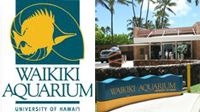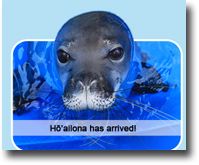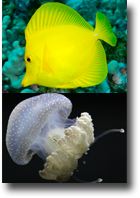Community website by MBC/Ernest Abrams. Call 808-739-9797 for advertising/sponsorship#KaimukiHawaii
Kaimuki Hawaii
News Item- Powered by MBC NewsMaker
Monk Seal Month at Waikiki Aquarium
- Tweet
 |
 Monk Seal Month
Monk Seal Month With the arrival of Hō‘ailona to Waik k Aquarium, we feel it's time to learn more about Hawaiian Monk seals. What do seals eat? How long do they hold their breath? How many are there? What can I do to help? With the arrival of Hō‘ailona to Waikiki Aquarium, we feel it's time to learn more about Hawaiian Monk seals. What do seals eat? $2/person (plus admission to the Aquarium). Registration required.
- Jul 12, Thu - 3:00-3:45 p.m.
- Jul 19, Thu - 3:00-3:45 p.m.
- Jul 26, Thu - 3:00-3:45 p.m.
ABOUT WAIKIKI AQUARIUM
 Founded in 1904 and administered by the University of Hawai'i at Manoa since 1919, the Waikiki Aquarium is located on the shoreline of Waikiki Beach next to a living reef and across from Kapiolani Park. The Aquarium -- third oldest in the U.S. -- showcases more than 500 marine species, and maintains more than 3,500 marine specimens. Public exhibits, education programs and research focus on the unique aquatic life of Hawai'i and the tropical Pacific.
Founded in 1904 and administered by the University of Hawai'i at Manoa since 1919, the Waikiki Aquarium is located on the shoreline of Waikiki Beach next to a living reef and across from Kapiolani Park. The Aquarium -- third oldest in the U.S. -- showcases more than 500 marine species, and maintains more than 3,500 marine specimens. Public exhibits, education programs and research focus on the unique aquatic life of Hawai'i and the tropical Pacific. The Aquarium welcomes more than 320,000 visitors annually, and is open daily from 9 a.m. to 4:30 p.m. except Honolulu Marathon Sunday and Christmas Day. Admission is $12 for visitors; $8 for local residents and active duty military with ID, $5 for senior citizens and juniors ages four to 12; and free for children three and under and Friends of Waikiki Aquarium (FOWA) members.
 MISSION:
MISSION:To inspire and promote understanding, appreciation
and conservation of Pacific marine life.
DESCRIPTION:
Founded in 1904, the Waikiki Aquarium is the third
oldest public aquarium in the United States. A part of the University of
Hawai`i at Manoa since 1919, it is located next to a living reef on the Waikiki
shoreline. Exhibits, programs, and research focus on the aquatic life of
Hawai`i and the tropical Pacific, with roughly 320,000 people visiting the
Aquarium each year. Over 3,500 organisms are on exhibit representing more than
500 species of aquatic animals and plants.
EXHIBITS:
Waikiki Aquarium exhibits focus on the diversity of
aquatic, shoreline and coral reef habitats and living communities of Hawai`i and
the tropical Pacific. Among the highlights:
- Corals Are Alive! interactive exhibits
showcasing corals, their biology and conservation - SeaVisions Theatre shows videos that
illustrate shoreline conservation and how you can be a responsible reef
visitor - South Pacific Marine Communities features
South Pacific habitats and species, including colorful reef corals and fishes,
giant clams, groupers and snappers and intriguing partnerships such as
anemonefishes and their host sea anemones - Hawaiian Marine Communities recreates
Hawaiian habitats from wave-swept surge zone to deep reef slopes, and from young
to ancient reefs; celebrates distinctive reef life, including the longnose
butterflyfish - Ocean Drifters Gallery features a
1,000-gallon moon jelly tank and a seasonally changing jelly wall that may
contain white-spotted jellies, blue blubbers, sea nettles, box jellies and
ctenophores - Hunters on the Reef 35,000-gallon exhibit
is home to Hawaiian sharks and jacks; shark interpretive panels introduce shark
biology, research, conservation and safety. New Spyball camera provides up close
shark encounters in real time on a television screen - Edge of the Reef naturalistic shoreline
exhibit offering opportunities for supervised observation and hands-on
interactions with selected marine life - The Coral Farm exhibit and working research
facility for propagation of reef corals - Giant Clams exhibit and working research
facility for propagation of clams - Hawaiian Monk Seal Habitat features the
endangered Hawaiian Monk Seal found only in the Hawaiian Islands - Aquaculture features moi, a popular food
fish, whose numbers have declined in the wild - Coastal Gardens with native Hawaiian plants
adapted for life close to the sea
Hawaiian monk seals; ‘öhai (endemic
Hawaiian coastal plant)
UNIQUE SPECIES:
Pacific giant clams; Hawaiian stream gobies; rare
deep-reef butterflyfish; bearded armorheads; masked angelfish; and diverse
native coastal plants
CONSERVATION & RESEARCH:
The Waikiki Aquarium is a working research facility,
conducting numerous conservation and research programs, including:
- Husbandry, nutrition and behavior of aquatic and marine
aquarium specimens - Husbandry and propagation of chambered
nautilus - Spawning behavior, larval rearing, and propagation
potential of selected reef fishes - Identification & treatment of diseases, parasite
infections and other ailments of aquarium marine life - Coral husbandry, propagation and conservation
- Hawaiian monk seal metabolic and bacteriological
research - Giant clam husbandry and propagation
- Sea jelly husbandry and propagation
- Deep reef coral research
- Coral Ark: archiving and husbandry of rare Hawaiian
corals
The Waikiki Aquarium offers numerous education programs,
including:
- Interpretive services: staff or volunteers enrich
the visitor experience with explanations of the exhibits, demonstrations, and
hands-on experiences - Self-tour opportunities for individuals and
groups: interpretive graphics & exhibits, handouts are
available. - School Program: presentations and docent-assisted
tours for school groups, grades K - 6 - Outreach and special request presentations for
schools and community groups - Community Enrichment Program: year-round natural
history fieldtrips, classes, and workshops for children, families, and
adults - Information services: staff answer questions from
visitors & community on marine and aquarium-science related
topics
The Waikiki Aquarium affords a number of opportunities
to get involved through:
- Membership: Join the Friends of the
Waikïkï Aquarium (FOWA) to enjoy the annual benefits of free
admission, 20% discount at the Natural Selections gift shop, quarterly mailings
of our beautiful and informative magazine Kilo i’a, free salt water
pick-up, and facility rental privileges at “Family” and
“Family Plus” levels. To select the membership level right for you,
please see the Visitor Services staff or contact Events and Membership Manager
Raina Fujitani at (808) 440-9008 for more information. - Volunteerism: When you donate your time and
curiosity to the Waikiki Aquarium, you are rewarded with diverse and challenging
opportunities to help make a difference!- Education
– Docents provide on-site presentations and tours to elementary school
groups and provide outreach programs for school and community groups.
Interpreters at the Edge of the Reef exhibit assist visitors and provide
up-close observations of Hawaiian marine life. - Live
Exhibits – Assist with husbandry, tank maintenance and
feeding. - Natural
Selection Shop – Assist with stocking inventory and sales. - Membership/Public
Relations/Special Events - Assist with bulk mail outs & communications
with Aquarium members, public relations surveys, record-keeping and special
events.
- Education
The Waikiki Aquarium has received several awards for its
research and conservation efforts, including:
- 2008 Keep It Hawai`i Award
- 2003 Munson Aquatic Conservation Exhibit (M.A.C.E.) Award
from the American Zoo & Aquarium Association (AZA) for South Pacific Marine
Communities exhibit - 2003 Edward H. Bean Award from AZA for Long Term Tropical
Pacific Coral Propagation Program
Rossiter
EMPLOYEES: 35 full-time, 36 part-time, 33
affiliate staff
HOURS: 9 a.m. to 4:30 p.m. daily (except
Honolulu Marathon Sunday and Christmas Day)
ADMISSION: $12 for visitors; $8 for local residents and active duty military with ID, $5 for senior citizens and juniors ages four to 12; and free for children three and under and Friends of Waikiki Aquarium (FOWA) members.
Questions? Ready for an appointment?
Featured Product/Service
- RELATED LINKS

 Waikiki Aquarium
Waikiki Aquarium
Founded in 1904, the Waikiki Aquarium is the second oldest public aquarium in the United States. A part of the University of Hawai`i at Manoa since 1919, it is located next to a living reef on the Waikiki shoreline.
 Kaimuki Hawaii.Com Home Page
Kaimuki Hawaii.Com Home Page
View our featured events, news, businesses and primary links on our home page. Featured Sponsors
Featured Sponsors
Great offers from our sponsors who support the Kaimuki Honolulu, Hawaii community. More...
Kaimuki Hawaii Directory
View Kaimuki, Hawaii primary directories. businesses, non profits, public, government and jobs. Calendar
Calendar
Check out things to do in Kaimuki on the calendar of events. News and Newsletters
News and Newsletters
Keep up with the latest news and happenings in your Kaimuki community. Kaimuki Hawaii Featured Pages
Kaimuki Hawaii Featured Pages
View our directory of feature pages showcasing all the great things Kaimuki, Honolulu, Hawaii has to offer. Go Green in Kaimuki, restaurants, shopping, WiFi Hot Spots, fitness, health, real estate, home and garden, 80+ more directories... More...
Please send questions about this website to
webmaster@kaimukihawaii.com
Copyright© 2005 - 2020 KaimukiHawaii.com. All rights reserved.
Terms of Use / Legal Disclaimer / Privacy Statement
Site Designed and Managed by MacBusiness Consulting
Terms of Use / Legal Disclaimer / Privacy Statement
Site Designed and Managed by MacBusiness Consulting
